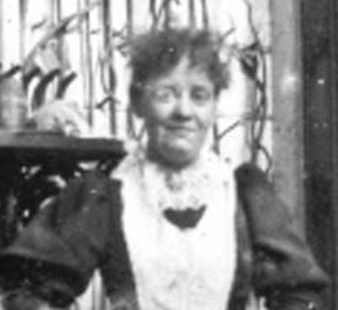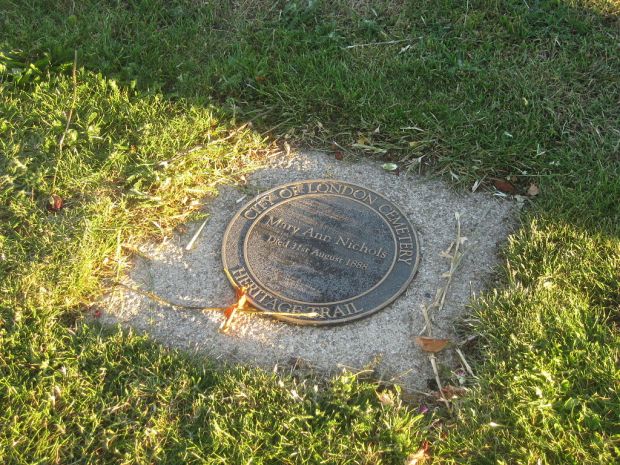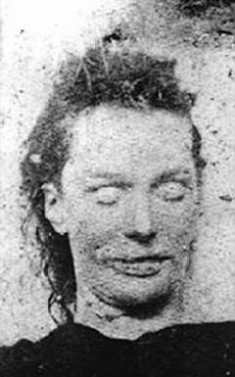
August 31 will mark the 134th anniversary of the Ripper’s first victim, Mary Ann Nichols.
As London’s bells rang in the last day of August 1888, rain was falling. It had been one of the wettest summers in living memory, and there was thunder in the air. On the horizon a fierce red glow seared the sky above Shadwell, where a huge fire had broken out in the dry dock.
Some time between one and two o’clock that morning, a woman called Mary Ann Nichols, known to her friends as ‘Polly’, was thrown out of the kitchen of the shabby lodging house at 18 Thrawl Street, Spitalfields. Fate had dealt Polly a rough hand. A 43-year-old mother of five children, she was separated from her husband and now drifted from one workhouse to another, scratching a meagre existence from handouts and casual prostitution.
Short of the four pence she needed to pay for a bed in the lodging house, Polly once more found herself on the street. “Never mind,” she said, gesturing at the velvet-trimmed straw bonnet she was wearing. “I’ll soon get my doss money. See what a jolly bonnet I’ve got now.” The implication was clear: she was heading back out to find a punter.
An hour or so later, Polly was seen by one of her roommates on the corner of Whitechapel Road, clearly drunk. She had made her doss money three times over, she boasted, but had already spent it on gin and was off to make some more.
That was the last time Mary Ann Nichols was seen alive. At 3.40am, a carter found her lying in the darkened doorway of a stable. Her throat had been slit and her body horribly mutilated. The murderer who would later be dubbed ‘Jack the Ripper’ had claimed his first victim.

Born Mary Ann Walker on August 26, 1845 in Dawes Court, Shoe Lane, off Fleet Street. She was christened in or some years before 1851. At the time of her death the East London Observer guessed her age at 30-35. At the inquest her father said “she was nearly 44 years of age, but it must be owned that she looked ten years younger.
5’2” tall; brown eyes; dark complexion; brown hair turning grey; five front teeth missing (Rumbelow); two bottom-one top front (Fido), her teeth are slightly discoloured. She was described as having small, delicate features with high cheekbones and grey eyes. She had a small scar on her forehead from a childhood injury.
She was described as “a very clean woman who always seemed to keep to herself.” The doctor at the post mortem remarked on the cleanliness of her thighs. She was also an alcoholic.

Mary Ann was born to locksmith Edward Walker and his wife Caroline on 26 August 1845, in Dean Street in London. On 16 January 1864 she married William Nichols, a printer’s machinist, and between 1866 and 1879, the couple had five children: Edward John, Percy George, Alice Esther, Eliza Sarah, and Henry Alfred. Their marriage broke up in 1880 or 1881 from disputed causes. Her father accused William of leaving her after he had an affair with the nurse who had attended the birth of their final child, though Nichols claimed to have proof that their marriage had continued for at least three years after the date alleged for the affair. He maintained that his wife had deserted him and was practising prostitution.Police reports say they separated because of her drunken habit.
Legally required to support his estranged wife, William Nichols paid her an allowance of five shillings a week until 1882, when he heard that she was working as a prostitute; he was not required to support her if she was earning money through illicit means. Nichols spent most of her remaining years in workhouses and boarding houses, living off charitable handouts and her meagre earnings as a prostitute.She lived with her father for a year or more but left after a quarrel; her father stated he had heard she had subsequently lived with a blacksmith named Drew in Walworth.In early 1888, the year of her death, she was placed in the Lambeth workhouse after being discovered sleeping rough in Trafalgar Square.

In May she left the workhouse to take a job as a domestic servant in Wandsworth. Unhappy in that position—she was an alcoholic and her employer, Mr Cowdry, and his wife, were teetotallers—she left two months later, stealing clothing worth three pounds ten shillings.At the time of her death, Nichols was living in a Whitechapel common lodging house in Spitalfields, where she shared a room with a woman named Emily “Nelly” Holland.
At about 23:00 on 30 August, Nichols was seen walking the Whitechapel Road; at 00:30 on 31 August she was seen to leave a pub in Brick Lane, Spitalfields. An hour later, she was turned out of 18 Thrawl Street as she was lacking the fourpence required for a bed, implying by her last recorded words that she would soon earn the money on the street with the help of a new bonnet she had acquired. She was last seen alive standing at the corner of Osborn Street and Whitechapel Road at approximately 02:30 (one hour before her death) by her roommate, Emily Holland. To Holland, Nichols claimed she had earned enough money to pay for her bed three times that evening, but had repeatedly spent the money on alcohol.
At about 3:40, a cart driver named Charles Allen Lechmere (who also used the name Charles Cross) discovered Mary Ann Nichols lying on the ground in front of a gated stable entrance in Buck’s Row (since renamed Durward Street), Whitechapel, about 150 yards from the London Hospital and 100 yards from Blackwall Buildings.

Her skirt was raised. Another passing cart driver on his way to work, Robert Paul, approached and Cross pointed out the body. Cross believed her to be dead, but Paul was uncertain and thought she might simply be unconscious. They pulled her skirt down to cover her lower body, and went in search of a policeman. Upon encountering PC Jonas Mizen, Cross informed the constable: “She looks to me to be either dead or drunk, but for my part, I believe she’s dead.”The two men then continued on their way to work, leaving Mizen to inspect Nichols’ body.
As Mizen approached the body, PC John Neil came from the opposite direction on his beat and by flashing his lantern, called a third policeman, PC John Thain, to the scene. As news of the murder spread, three horse slaughterers from a neighbouring knacker’s yard in Winthrop Street, who had been working overnight, came to look at the body. None of the slaughterers, the police officers patrolling nearby streets, or the residents of houses alongside Buck’s Row reported hearing or seeing anything suspicious before the discovery of the body.
PC Thain fetched surgeon Dr Henry Llewellyn, who arrived at 04:00 and decided she had been dead for about 30 minutes.

Her throat had been slit twice from left to right and her abdomen mutilated with one deep jagged wound, several incisions across the abdomen, and three or four similar cuts on the right side caused by the same knife, estimated to be at least 6–8 inches (15–20 cm) long, used violently and downwards.Llewellyn expressed surprise at the small amount of blood at the crime scene, “about enough to fill two large wine glasses, or half a pint at the most”. His comment led to the supposition that Nichols was not killed where her body was found, but the blood from her wounds had soaked into her clothes and hair, and there was little doubt that she had been killed at the crime scene by a swift slash to the throat. Death would have been instantaneous, and the abdominal injuries, which would have taken less than five minutes to perform, were made by the murderer after she was dead. When a person is killed, further wounds to their body do not always result in a large amount of blood loss. When the body was lifted a “mass of congealed blood”, in PC Thain’s words, lay beneath the body.
As the murder had occurred in the territory of the Bethnal Green Division of the Metropolitan Police, it was initially investigated by the local detectives, inspectors John Spratling and Joseph Helson, who had little success. Elements of the press linked the attack on Nichols to two previous murders, those of Emma Elizabeth Smith and Martha Tabram, and suggested the killing might have been perpetrated by a gang, as in the case of Smith.[The Star newspaper instead suggested a single killer was the culprit and other newspapers took up their storyline. Suspicions of a serial killer at large in London led to the secondment of Detective Inspectors Frederick Abberline, Henry Moore and Walter Andrews from the Central Office at Scotland Yard.

Although Nichols carried no identification, a Lambeth workhouse laundry mark on her petticoats gave police enough information to eventually identify her. Nelly Holland and William Nichols confirmed an identification provided by a former workhouse resident.While her death certificate states that she was 42 at the time of her murder (an apparent error reflected on her coffin plate and gravestone), birth records indicate she was 43, a fact confirmed at her inquest by her father, who described her as looking “ten years younger” than her age. The coroner at Nichols’ inquest, which began on 1 September at the Working Lads’ Institute on Whitechapel Road, was Wynne Edwin Baxter. Inquest testimony as reported in The Times stated:
Five of the teeth were missing, and there was a slight laceration of the tongue. There was a bruise running along the lower part of the jaw on the right side of the face. That might have been caused by a blow from a fist or pressure from a thumb. There was a circular bruise on the left side of the face which also might have been inflicted by the pressure of the fingers. On the left side of the neck, about 1in. below the jaw, there was an incision about 4in. in length, and ran from a point immediately below the ear. On the same side, but an inch below, and commencing about 1in. in front of it, was a circular incision, which terminated at a point about 3in. below the right jaw. That incision completely severed all the tissues down to the vertebrae. The large vessels of the neck on both sides were severed. The incision was about 8in. in length. The cuts must have been caused by a long-bladed knife, moderately sharp, and used with great violence.
No blood was found on the breast, either of the body or the clothes. There were no injuries about the body until just about the lower part of the abdomen. Two or three inches from the left side was a wound running in a jagged manner. The wound was a very deep one, and the tissues were cut through. There were several incisions running across the abdomen. There were three or four similar cuts running downwards, on the right side, all of which had been caused by a knife which had been used violently and downwards. The injuries were from left to right and might have been done by a left-handed person. All the injuries had been caused by the same instrument.
Although Llewellyn had speculated that the attacker could have been left-handed, he later expressed doubt over this initial thought, but the belief that the killer was left-handed endured.
Rumours that a local character called “Leather Apron” could have been responsible for the murder were investigated by the police, even though they noted “there is no evidence against him”. Imaginative descriptions of “Leather Apron”, using crude Jewish stereotypes, appeared in the press,but rival journalists dismissed these as “a mythical outgrowth of the reporter’s fancy”.John Pizer, a Polish Jew who made footwear from leather, was known by the name “Leather Apron” and was arrested despite a lack of evidence.He was soon released after the confirmation of his alibis. Pizer successfully obtained monetary compensation from at least one newspaper that had named him as the murderer.
After several adjournments, to allow the police to gather further evidence, the inquest concluded on 24 September. On the available evidence, Coroner Baxter found that Nichols was murdered at just after 3 a.m. where she was found. In his summing up, he dismissed the possibility that her murder was connected with those of Smith and Tabram since the lethal weapons were different in those cases, and neither of the earlier cases involved a slash to the throat.However, by the time the inquest into Nichols’ death had concluded, another woman, Annie Chapman, had been murdered, and Baxter noted “The similarity of the injuries in the two cases is considerable.” The police investigations into the murders of Chapman and Nichols were merged.
The subsequent murders of Elizabeth Stride and Catherine Eddowes the week after the inquest had closed, and that of Mary Jane Kelly on 9 November, were also linked by a similar modus operandi, and the murders were blamed by the press and public on a single serial killer, called “Jack the Ripper”.
In recent years it has been suggested that Charles Cross, the person who supposedly found her body, was the Ripper.
Nichols was buried on 6 September 1888. That afternoon, her body was transported in a polished elm coffin to Mr Henry Smith, Hanbury Street undertaker. The cortege consisted of the hearse and two mourning coaches, which carried William Nichols and Edward John Nichols (her eldest son, who was approximately 22 years old). Nichols was buried at the City of London Cemetery, in a public grave numbered 210752 (on the edge of the current Memorial Garden).
In late 1996, the cemetery authorities decided to mark her grave with a plaque.




































































You must be logged in to post a comment.